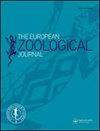The use of drones to study the breeding productivity of Whooper Swan Cygnus cygnus
IF 1.6
4区 生物学
Q2 ZOOLOGY
引用次数: 2
Abstract
Abstract This research was carried out in north-eastern Poland, where Whooper Swan Cygnus cygnus is a sparse breeder. Whooper Swan is timid and exhibits a tendency to hide in emergent vegetation. A drone was used to improve the effectiveness of research into its breeding success and offspring productivity. The breeding density of Whooper Swan in the study area in 2022 was 10 pairs/100 km2. The number of breeding birds detected at the beginning of the breeding season did not differ according to the method used (drone vs ground). The breeding productivity of the sample of swans studied (N = 36) was 2.19 cygnets per breeding pair using the ground method, but 3.71 per pair with the drone, a significant difference (p-value of the Wilcoxon test = 0.0148). The traditional method showed that 50% of the pairs had bred successfully, whereas with the drone this figure was 79%. The birds either did not react to the drone’s presence or else moved slowly away. The drone study of Whooper Swan breeding productivity was considerably faster (9 min per site vs 1–2 h ground survey), more precise, and less invasive for the birds than a traditional ground survey.使用无人机研究天鹅座天鹅繁殖生产力
本研究是在波兰东北部进行的,那里的大天鹅Cygnus Cygnus是一个稀疏的繁殖者。大天鹅胆小,倾向于躲在新兴的植被中。一架无人机被用来提高其繁殖成功率和后代生产力的研究效率。研究区2022年大天鹅繁殖密度为10对/100 km2。在繁殖季节开始时检测到的繁殖鸟类数量根据使用的方法(无人机和地面)没有差异。所研究的天鹅样本(N = 36),地面法的繁殖效率为2.19只/对,而无人机法的繁殖效率为3.71只/对,差异有统计学意义(Wilcoxon检验的p值= 0.0148)。传统方法显示,50%的配对成功繁殖,而无人机的这一数字为79%。这些鸟要么对无人机的存在没有反应,要么慢慢地飞走了。与传统的地面调查相比,无人机研究大天鹅繁殖生产力的速度要快得多(每个地点9分钟,地面调查1-2小时),更精确,对鸟类的侵入性更小。
本文章由计算机程序翻译,如有差异,请以英文原文为准。
求助全文
约1分钟内获得全文
求助全文
来源期刊

European Zoological Journal
Agricultural and Biological Sciences-Animal Science and Zoology
CiteScore
3.10
自引率
5.60%
发文量
80
审稿时长
30 weeks
期刊介绍:
The European Zoological Journal (previously Italian Journal of Zoology) is an open access journal devoted to the study of all aspects of basic, comparative and applied protozoan and animal biology at molecular, cellular, tissue, organ, organismal, population, and community-ecosystem level. Papers covering multiple levels of organization and integrative approaches to study animal form, function, development, ecology, evolution and systematics are welcome. First established in 1930 under the name of Il Bollettino di Zoologia, the journal now has an international focus, reflected through its global editorial board, and wide author and readership.
 求助内容:
求助内容: 应助结果提醒方式:
应助结果提醒方式:


